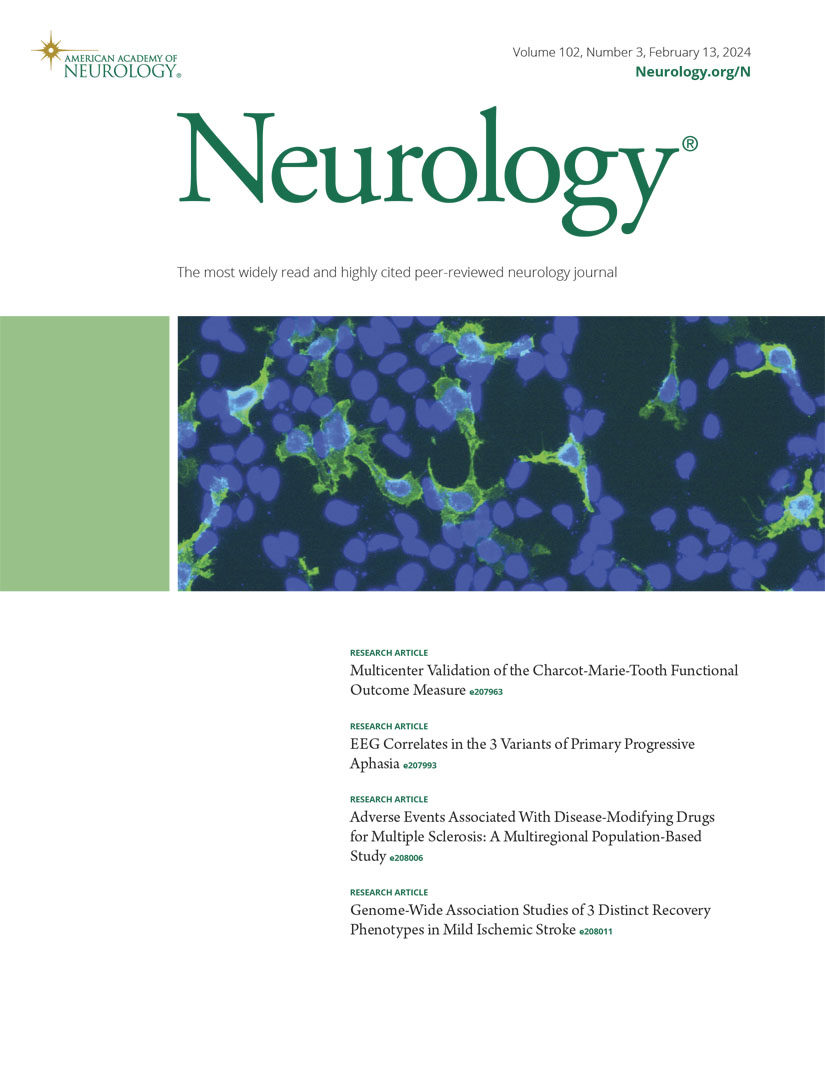Association of Superficial White Matter Microstructure With Cortical Pathology Deposition Across Early Stages of the AD Continuum.
IF 7.7
1区 医学
Q1 CLINICAL NEUROLOGY
引用次数: 0
Abstract
BACKGROUND AND OBJECTIVES β-amyloid (Aβ) and tau, 2 prominent pathologies of Alzheimer disease (AD), originate in cortical regions and primarily affect, and even spread along, the white matter tracts directly connected to these cortical regions. Superficial white matter (SWM), containing short-range association connections beneath the cortex, has been affected in mild cognitive impairment and AD, with gaps in understanding the disease's early stages. We perform a detailed investigation of individual SWM connections with cortical pathology deposition and cognition in the early stages of the AD continuum. METHODS We enroll participants with Aβ PET, tau PET, diffusion MRI, and cognitive status from the Alzheimer's Disease Neuroimaging Initiative (ADNI) and Harvard Aging Brain Study (HABS). We stratify participants into disease stages following the Aβ/tau (AT) framework. We use diffusion MRI tractography to analyze SWM fiber clusters and assess their microstructure through free-water modeling, identifying significant differences between pathologically staged groups. We investigate associations of diffusion measures in SWM fiber clusters with regional pathology deposition (Aβ- and tau- PET uptake) and cognition. RESULTS The study includes 150 ADNI participants (mean age 73.6 years, 61.3% female) and 175 HABS participants (mean age 75.6 years, 61.1% female). We find the following: (1) SWM microstructure differs along the early-stage Alzheimer disease continuum, with primary abnormalities in posterior brain regions; (2) there are significant free-water alterations in cognitively intact but pathology-positive individuals (p < 0.05, false discovery rate [FDR] corrected); (3) associations are identified between free water in SWM connections and proximal pathologic deposition, as well as between free water in several connections and memory function (standardized β coefficient = [-0.297 to -0.352], all p < 0.05, FDR corrected); and (iv) free water of a temporal SWM connection mediates the impact of temporal tau on memory (95% CI = [-0.146 to -0.002], accounts for 15.0% of the total effect). DISCUSSION The findings of this study suggest that the propagation of AD pathology and cognitive changes may involve SWM pathways even in the early stages, emphasizing the importance of SWM in developing AD therapies and early interventions.浅表白质微结构与阿尔茨海默病早期皮层病理沉积的关系。
背景与目的β-淀粉样蛋白(Aβ)和tau蛋白是阿尔茨海默病(AD)的两种主要病理,它们起源于皮层区域,主要影响甚至沿与这些皮层区域直接相连的白质束扩散。在轻度认知障碍和阿尔茨海默病的早期阶段,包含皮层下短程关联连接的浅表白质(SWM)受到了影响。我们对个体SWM与皮层病理沉积和认知在AD连续体早期阶段的联系进行了详细的调查。方法:我们招募了来自阿尔茨海默病神经影像学倡议(ADNI)和哈佛衰老脑研究(HABS)的Aβ PET、tau PET、弥散MRI和认知状态的参与者。我们根据Aβ/tau (AT)框架将参与者按疾病阶段进行分层。我们使用弥散MRI纤维束成像分析SWM纤维簇,并通过自由水模型评估其微观结构,确定病理分期组之间的显著差异。我们研究SWM纤维簇的扩散措施与区域病理沉积(Aβ-和tau- PET摄取)和认知的关系。结果共纳入150例ADNI参与者(平均年龄73.6岁,女性61.3%)和175例HABS参与者(平均年龄75.6岁,女性61.1%)。研究发现:(1)SWM微结构在早期阿尔茨海默病连续体中存在差异,主要异常发生在脑后部;(2)认知完整但病理阳性的个体存在显著的自由水改变(p < 0.05,错误发现率[FDR]得到纠正);(3) SWM连接中的自由水与近端病理沉积之间存在关联,以及几个连接中的自由水与记忆功能之间存在关联(标准化β系数=[-0.297至-0.352],均p < 0.05, FDR校正);(iv)颞叶SWM连接的自由水介导了颞叶tau对记忆的影响(95% CI =[-0.146至-0.002],占总效应的15.0%)。本研究结果表明,即使在早期阶段,AD病理和认知变化的传播也可能涉及SWM途径,强调了SWM在开发AD治疗和早期干预中的重要性。
本文章由计算机程序翻译,如有差异,请以英文原文为准。
求助全文
约1分钟内获得全文
求助全文
来源期刊

Neurology
医学-临床神经学
CiteScore
12.20
自引率
4.00%
发文量
1973
审稿时长
2-3 weeks
期刊介绍:
Neurology, the official journal of the American Academy of Neurology, aspires to be the premier peer-reviewed journal for clinical neurology research. Its mission is to publish exceptional peer-reviewed original research articles, editorials, and reviews to improve patient care, education, clinical research, and professionalism in neurology.
As the leading clinical neurology journal worldwide, Neurology targets physicians specializing in nervous system diseases and conditions. It aims to advance the field by presenting new basic and clinical research that influences neurological practice. The journal is a leading source of cutting-edge, peer-reviewed information for the neurology community worldwide. Editorial content includes Research, Clinical/Scientific Notes, Views, Historical Neurology, NeuroImages, Humanities, Letters, and position papers from the American Academy of Neurology. The online version is considered the definitive version, encompassing all available content.
Neurology is indexed in prestigious databases such as MEDLINE/PubMed, Embase, Scopus, Biological Abstracts®, PsycINFO®, Current Contents®, Web of Science®, CrossRef, and Google Scholar.
 求助内容:
求助内容: 应助结果提醒方式:
应助结果提醒方式:


